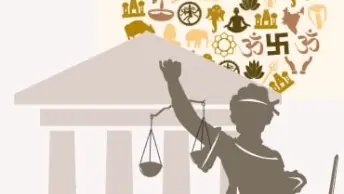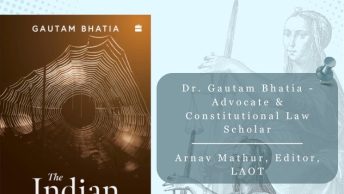Introduction
In light of the upcoming review of the Essential Religious Practices Test at the Supreme Court of India, there needs to be exploration of the possible roadmaps for the judiciary. This piece tries to explore the notion of secularism in India and offer a plausible solution.
The Constituent Assembly Debates reveal that political dynamics surrounding secularism have been particularly difficult to navigate since its very inception, considering the communal tensions at the time of independence. Secularism was deemed a necessary ideal for the newly free democratic nation considering the divisive and painful genesis of the sovereign. The Constitution guaranteed that the State “shall not discriminate against any citizen on grounds only of religion”, and that “all persons are equally entitled to freedom of conscience and the right freely to profess, practise and propagate religion.” The fundamental right to freedom of religion enshrined under Article 25 of the Constitution meant that the State would proactively ensure no one is deprived of preaching and practicing their faith. Notably however, there was a promise of the State actively intervening into religious affairs in the opening clause to Article 25 where the freedom to have one’s religious beliefs was subjected “to public order, morality and health and to the other provisions of this Part.” This is a momentous departure from the popular and, admittedly, original understanding of ‘secularism’ of the separation of the Church and the State.
The Indian judiciary has through the decades played a proactive part in forming the legal understanding of religion, conceptualising certain core structural elements of the religion and protecting only those essential religious practises during conflicts with public policy. This piece attempts to analyse these judgements and arrive at a better functional framework to protect the individual’s faith, while promoting the social policies enshrined under the Constitution.
In Articles of Faith: Religion, Secularism, and the Indian Supreme Court, Ronojoy Sen provides a critical examination of how the Supreme Court has interpreted and applied secularism. He argues that the Court by accepting that there exists a ‘pure’ form of Hinduism that practises inclusive Vedantic beliefs, has paradoxically echoed the exclusivist philosophy of Hindutva, which also propounds the existence of a Hindu identity ‘inimical to variations in beliefs, practises and doctrines’.
This shows how unintentionally the judiciary breached the political peripheries and contributed to the acceptance of fundamentalist thought. This piece aims at analysing how the Indian courts have treated religious belief to be analogous to religion’s principles. The article aims to argue how the constitutional protection in India was intended towards the individual’s faith and not the religion, per se. The objective is to differentiate between individual faith and religion and establish the supremacy of the protection of the earlier as a constitutional value.
The piece will first navigate the Indian understanding of secularism and map how the judicial interpretation strayed away from the intention of the Constitutional provisions and resultantly, lost connection with the grassroot religious beliefs of the people. Thereafter, it will offer an alternative by proposing a legal distinction.
Secularism With Indian Characteristics: Introspecting into the polity
During the Constituent Assembly Debates, KM Munshi took note of the State’s active role of recognising the role of ‘religious belief’ in public life. According to him, passing the fundamental right (to religion) was to meet this very end-goal.
Indian judiciary offered a succinct definition of secularism in the landmark judgement of S.R. Bommai v. Union of India by holding that
“These provisions by implication prohibit the establishment of a theocratic State and prevent the State either identifying itself with or favouring any particular religion or religious sect or denomination. The State is enjoined to accord equal treatment to all religions and religious sects and denominations.”
State Interference in Religious Matters – Why and How Much?
The paradigm of essential religious practice diminished the Constitution’s notable strides towards encouraging interference of the State in religious affairs in public interest. The State has a broad scope in regulating religious affairs, as highlighted in the Sri Jagannath judgement of 1997, which distinguished between religious freedom and secular matters connected to religion. This includes overseeing temple management, considered a secular act in Indian jurisprudence. The Indian Supreme Court’s interpretation of secularism is unique, allowing for restrictions on economic activities related to religion, such as cow slaughter.
Article 17 of the Constitution abolished untouchability, challenging the conservative religious orthodoxy that had denied lower castes access to places of worship. Brahmins, who previously considered untouchables impure, could no longer prevent them from entering temples, as this practice conflicted with the fundamental rights of Dalits and lower castes to practice their faith. The concept of caste purity, integral to Brahminical Hinduism, was directly outlawed by Article 16, regardless of its religious justification.
But the Judiciary did not take this radical Constitutional approach to deal with the consequent judgements regarding the entry of lower caste individuals into temples. The ERP Test resorts to examining the scriptures and works of Hindu scholars to argue against the Brahmin’s discriminatory beliefs towards how Hinduism must be preached – it rather helps the judiciary argue how such caste barriers are no-where intrinsic to Hinduism, and which beliefs brings a group or sect under the purview of broader Hindu thought (thus legally making it synonymous to Hinduism).
This piece offers a three -pronged critique to this:
Firstly, this approach might have been liberatory for social reforms and religious studies, but the catch here is that, delving into such theological dissertations should never be the role of the Common Law Judiciary. The chain of arguments here implies that the Court could not have intervened to fight for the right of the lower castes if the religious scriptures allowed such inhumane discrimination. Thus, this approach defeats the radical spirit of the Constitution.
Secondly, the Constitution was meant to grant its citizens the ‘liberty of thought, expression, belief, faith and worship‘. This calls for a distinction within the understanding of ‘religious thought’ – between an individual’s faith and the collective idea of religion which encompasses socio-cultural history and tradition. This is imperative for a Constitutional approach towards securing religious right because a theist individual’s faith may develop naturally out of conscientious thought and spiritual experiences, but their religious beliefs are invariably shaped by their socio-cultural experiences. The Indian courts were not sensitive to this difference between individual faith and religion.
Here, the third prong of criticism also arises: When the Court refuses to accept that discrimination on the basis of caste is an inseparable part of the Hindu religion, as some Brahmins believed, they are directly disputing a community’s concept of religion – they are declaring that the Brahmins have a wrong idea about religion. If they simply outlawed such inhumane treatment directly, this would not have directly challenged their conception of Hinduism. The Brahmins may think that entry of Dalits make temples impure, but the Constitution does not allow such a practice. This makes it clear how much the judiciary went out of its way to opine on purely religious thought.
Essential versus Non-Essential Practises Debate
The closest Indian judiciary came to noting this subtlety was in the landmark Shirur Mutt Case of 1954, the first post-Independence case to deal with the ERP doctrine in religious jurisprudence and set guidelines to identify the constituents of a religious denomination. The Madras Hindu Religious and Charitable Endowments Act was challenged as infringing upon Article 26. Mukherjea J. wrote the judgement, borrowing from examples from American and Australian courts, and explicitly rejecting how the US defined ‘religion’.
Indicating a particular aspect of religion that transcended the socio-cultural traditions and practices, Stephen J. Field J. noted a distinction between one’s personal relation to the Creator and the ‘cultus of form or worship of a particular sect.’
This essence in particular can be termed as the individual’s faith which is a paramount aspect of one’s assortment of civil rights. However, Mukherjea J. noted that this definition was not compatible with the ‘Godless’ religions of Buddhism or Jainism native to India. He found the Indian Constitutional ethos to resonate more with that of the Australian Constitution’s principle of going “far beyond protecting liberty of opinion. It protects also acts done in pursuance of religious belief as part of religion.”
Treating faith as a sacrosanct aspect of spirituality beyond religious sects would lead to an altered path for the Indian interpretation of the ERP doctrine. Therefore, analysing the need for an ERP Test in the first place becomes crucial in order to suggest alternatives to the same.
Search Among Scriptures
Notable progress in the status quo of jurisprudence would be followed in Sastri Yagnapurushadji v Muldas Brudardas Vaishya (1966), where the Satsangis denied Dalits entry to their temple, claiming their worship of Lord Swamynarayan, a mystic ascetic, exempted them from the requirement to comply with the ‘throwing open’ of temples. Gajendragadkar J. debunked this defence by referring to religious texts and authorities, thereby extending the essential v. non-essential debate of Shirur Mutt. This reliance on the works of religious leaders and experts in Oriental theology was flawed since the law cannot be governed by any academic understanding of the religion, but must take into consideration the local beliefs, customs and practices that are essential to the community’s faith. However, if these beliefs contravene the State policy, the judiciary must promptly defenestrate them.
The unfortunate logical corollary of this judgement is the reductionist approach it takes to the faith of the group. The Satsangis were discriminating against those of lower caste and restricting their religious rights. This has nothing to do with them being a Hindu or whether ‘pure’ Hinduism, as per the scriptures, allows this discrimination. Here, there is an implication that the Court submitted to the presumption that, if permitted by religion, violating the rights of the people from lower castes would be justified. This very notion runs contradictory to its societal aspirations of the Constitution.
By adopting the said distinction between faith and religion, the judiciary must make a secular attempt at outrightly outlawing a certain group’s discriminatory religious beliefs by deeming such faith to be in contravention to the Constitution. The ERP test regime does not allow for such a strict stance, and only by replacing it can the Indian Courts provide more nuanced and progressive rulings that respect individual faith, while still aligning with the broader religious framework.
In assessing the applicability of the Satsang judgment, it is evident that the Court could have rendered its decision without delineating the fundamental tenets of Hinduism. Justice Gajendragadkar’s decision was an effort to acknowledge the pluralistic dimensions of Hinduism, but it falls short as a sound judgment. The Court should have prioritized the individual’s faith over rigid religious classifications. Such an approach would have mitigated the risk of reinforcing religious homogeneity and instead acknowledged the intrinsic personal nature of faith. In a constitutional republic, it is paramount that faith takes precedence over religious doctrine.
Conclusion
The static nature of public policy regarding religion may be a contributing factor to the present issues. The ERP approach, while ambitious and indicative of a significant step towards religious reform, was an instance of judicial overreach into religious spheres and, therefore, a flawed legal precedent. It should thus be recognized that the notion of ‘faith’ is inherently personal and individual, distinct from religious identity. Religion, in this context, serves merely as a framework through which personal faith is expressed. The grave Constitutional question thus lies in not whether the religion tolerates a certain act, but whether the Constitution does.
Ayush Dutta is a second year student at Hidayatullah National Law University. He can be reached at ayushdutta315@gmail.com.
Ed note: This piece was reviewed by Hamza Khan and published by Abhishek Sanjay from the Student Team.







Your blog post was the perfect blend of informative and entertaining. I couldn’t tear my eyes away from the screen!
You’ve done a fantastic job with this article. It’s well-researched, easy to digest, and covers all the bases without overwhelming the reader. Great work!
It’s rare to see such well-balanced coverage of a complex subject. You did an excellent job at presenting multiple viewpoints while staying objective. Kudos!
I enjoyed how you combined theoretical knowledge with practical advice. This article was not only informative but also full of useful tips and strategies.
The quality of this article is exceptional. The way you presented each aspect of the topic was clear, making this a highly informative and enjoyable read.
I loved the clarity and precision in this article. You really know how to make a complex topic feel approachable while still diving deep into the details.
Your ability to explain such intricate concepts in a way that’s both informative and easy to follow is what makes this article so engaging. Well done!
I’m truly impressed by how well you explained such a complex topic. Your approach is both thorough and easy to follow, which made the article a pleasure to read.
Your blog post was like a warm hug on a cold day. Thank you for spreading positivity and kindness through your words.
Thank you for sharing your expertise on this subject. Your blog post has given me a whole new perspective and plenty of food for thought.
1R1TkZxJcDo
H4Rla0uZScn
ikGWCkbc4oB
3pSbYxF9CNc